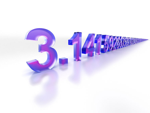 Before getting to the main topic of today's post, I have a couple of announcements to make!
Before getting to the main topic of today's post, I have a couple of announcements to make!
First, I've normally tried to post on Thursdays and Sundays on this blog, but regular commitments are taking priority, so I'm going to be posting on Sundays only for the time being.
Second, I recently created a new subreddit all about mental math techniques. If you're on reddit.com, please subscribe and contribute your own thoughts and links! Since it's often quicker to post links there, this may hopefully compensate for the difference in the blog posting schedule.
The rest of today's post will be about calculating powers of e in your head. Wait...what exactly is “e”?!? That's a great place to start.
BASICS: When mathematicians refer to e, they're referring to a specific number, approximately 2.71828 (it goes on forever, just like Pi), that is used to calculate continuous growth.
How can one number be used to calculate continuous growth? Why is it that particular number? The best place to understand these and other questions about e is to read BetterExplained.com's post An Intuitive Guide To Exponential Functions & e. It really is the best way to wrap your head around e as a number.
What exactly will you be working out in your head? Given an exponent x, you'll be able to take a problem of the form ex, and turn it into a power of 10 (in other words, you'll figure out y in 10y).
The technique I'll teach is based on the fact that we can take the general problem ex = 10y and isolate y by turning the problem into a logarithm: log10(ex) = y. Thanks to standard logarithm rules, we can turn this into the following form: x × log10(e) = y. A little help from Wolfram|Alpha tells us that this can further be simplified to the following form: x × 0.4342944... = y
OK, I hear you say, we've turned a seemingly complex exponential problem into a multiplication problem, but it doesn't seem easy to multiply by a number like 0.4342944 in your head! What we're actually going to be doing is approximating this number by multiplying by 0.4343. Yes, we'll be adjusting for the approximation, as well. Further, we're going to break that up into several steps, by turning it into the form (43 × 101)⁄10,000.
Yes, I have a few tricks up my sleeve to help you make these calculations at each stage, and I'll teach them in the next section.
TECHNIQUE: Let's start with a simple example of working out e16 as we go through each of the following steps.
MULTIPLYING BY 43: Take the exponent and multiply it by 4. In our example, 16 is the exponent, and you should be able to quickly work out that 16 × 4 = 64.
Next, take the exponent and multiply it by 3. Continuing with our example, 16 × 3 gives us a total of 48.
To make things easier, we need to split this 2nd answer up into the 1s digit and everything else. In our example, instead of thinking of the answer as simply 48, think of it as “+ 4 with an 8 slapped on the end.” You'll always think of the multiple of 3 in this way. If multiplying by 3 resulted in, say, 312, you'd think of that as “+ 31 with a 2 slapped on the end.” This type of thinking will make it easier for the next step.
To complete this step, add the two answers together. In our example, we'd add 64 “+ 4 with an 8 slapped on the end.” The answer then, is 64 + 4, which is 68, with an 8 slapped on the end, which is 688. Yes, 43 × 16 is 688.
Dealing with say, 23? 23 × 4 = 92 and 23 × 3 = “+ 6 with a 9 slapped on the end.” 92 + 6 with a 9 slapped on the end is equal to 98 with a 9 slapped on the end, or 989. Practice multiplying by 43 in this way before moving on. You may be surprised how quickly you get used to it.
MULTIPLYING BY 101: When dealing with 2 digit numbers, multiplying by 101 is ridiculously easy, as you simply repeat the 2 digit number itself. 43 × 101 = 4343 and 86 × 101 = 8686.
For this feat, however, you'll have to be able to deal with multiplying 3- and 4-digit numbers by 101. Don't worry, though, it's still simple.
To multiply a 3- or 4-digit number by 101, split the original number up, with the 10s and 1s digit off to the right, the remaining digits off to the left, and imagine two placeholders in-between them.
So, continuing with our example, 688 would be split up into 6__88. That's 6, followed by 2 placeholders, followed by 88, the original 10s and 1s digit.
To fill the placeholders, simply add the numbers on either side of the placeholders. 6 + 88 = 94, so we put 94 in those empty spaces, resulting in the number 69488. Yes, you've just mentally worked out the answer to 16 * 4343 in your head!
You do have to watch for the times when the digits on either side of the place holder add up to more than 100. In that case, you have to add the 1 to the digits on the left to compensate.
For example, if you multiplied 44 by 43 earlier and worked it out to be 1892, you'd then split that into 18__92, and then add 18 + 92 to get 110. The 10 part goes in the middle, and the 1 from the hundreds place is added to the 18 to get 19. The result is 191092. This is simple, once you get used to it.
DIVIDING BY 10,000: This is the simplest part of all! Just take the number from the previous step, and move the decimal 4 places to the left.
In our continuing example, we worked out the number 69488. Moving the decimal 4 places to the left turns the number into 6.9488!
What about numbers like, say, 191092? that becomes 19.1092. Simple isn't it?
ADJUSTING FOR APPROXIMATION: Remember that the decimal approximation of the base 10 log of e is actually 0.4342944..., and we've multiplied by 0.4343. That's close, but those are still 2 different numbers.
To make your result more accurate, simply drop the last (rightmost) digit of your answer. Don't round up or down, just completely ignore the last digit!
For our example result of 6.9488, we'd drop the rightmost digit to get 6.948. With that step, you're done. In your head, you worked out that e16 ≈ 106.948. How close is that to the actual solution? According to Wolfram|Alpha, the actual answer is 106.9487, so your mental estimate is accurate as far as it goes!
Naturally, if the rightmost digit of your calculation is 0, this is done for you almost automatically.
THE FULL PROCESS ALL AT ONCE: To make sure you've got this, let's try and work out a bigger problem. This time, we'll calculate e27 = 10y.
- 27 × 4 = 108 and 27 × 3 = +8 with a 1 slapped on the end.
- 108 + 8 with a 1 slapped on the end is equal to 116 with a 1 slapped on the end, or 1161.
- 1161 becomes 11__61, and 11 + 61 = 72, so we get 117261.
- 117261 with the decimal moved 4 places to the left is 11.7261.
- Drop the rightmost digit to get the final estimate of 11.726.
REAL-LIFE EXAMPLE: In this Business Insider story, there's an anecdote involving the absurdity of 4.5% growth for 3,000 years. You can figure that out with e3,000 × 0.045.
To get our exponent, that's 3,000 × 0.045 = 300 × 0.45 = 30 × 4.5 = 3 × 45 = 135. So, the answer we need to estimate is e135.
- 135 × 4 = 540 and 135 × 3 = +40 with a 5 slapped on the end.
- 540 + 40 with a 5 slapped on the end is equal to 580 with a 5 slapped on the end, or 5805.
- 5805 becomes 58__05, and 58 + 05 = 63, so we get 586305.
- 586305 with the decimal moved 4 places to the left is 58.6305.
- Drop the rightmost digit to get the final estimate of 58.630 (or 58.63).
TIPS: e is all about continuous growth, which is basically all about scale. I suggest reading How to Develop a Sense of Scale, Using Logarithms in the Real World, and my own Visualizing Scale post. Viewing and recalling the classic Powers of Ten video can be useful for concrete comparisons, as well.
• By looking at the whole number part of the answer (the significand) and adding 1 to that, you can state the number of digits the full answer would have. In our 6.9488 example, we take the whole number part, the 6, and add 1 to get 7, so we can state that the answer is a 7-digit number. Having worked out e135 to be about 1058.63, we can state that the answer is a 59-digit (58 + 1) number!
• Practice estimating larger and larger powers of e, until you're comfortable dealing with numbers up into the low 200s. Since all you really need is to get comfortable with multiplying by 4 and 3, you can find tips for multiplying 2-digit numbers by 1-digit numbers here, and multiplying 3-digit numbers by 1-digit numbers here.
• To prevent yourself from having to deal with multiplying 5-digit numbers from 101, simply avoid exponents greater than 232. Being able to estimate up to e232 in your head is still impressive!
• You can handle exponents with a decimal in them by working them out as if they were a whole number, and then adjusting for an appropriate number of additional decimal points when you're moving the decimal point. For example, e1.6 is the same as e16, but with the decimal moved one place more to the left. Since e16 ≈ 106.948, it's easy to see that e1.6 ≈ 100.6948.
• If you want to take this a step further, and be able to say that e16 is roughly equal to 8.8 × 106, check out Nerd Paradise's Calculating Base 10 Logarithms in Your Head, the video Calculating logarithms in your head, and the PDF How to Quickly Calculate Logarithms to Three Decimal Places in Your Head.









